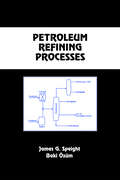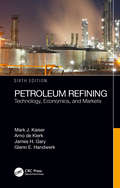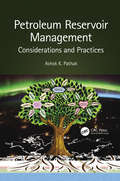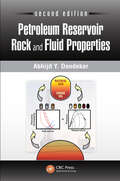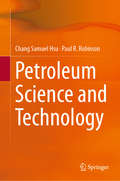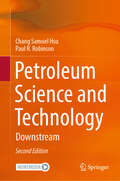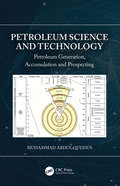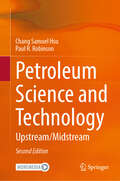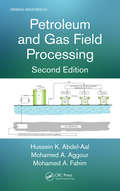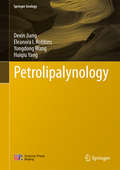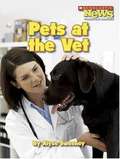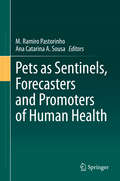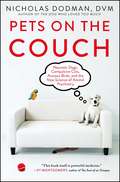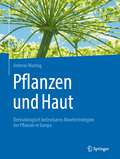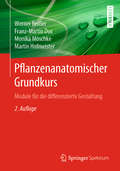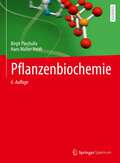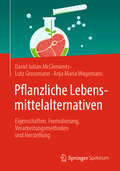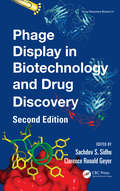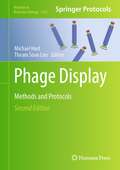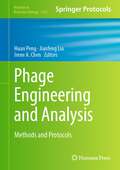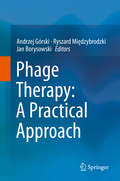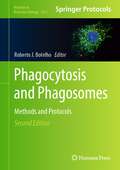- Table View
- List View
Petroleum Refining Processes (Chemical Industries)
by James G. Speight Baki ÖzümThis work highlights contemporary approaches to resource utilization and provides comprehensive coverage of technological advances in residuum conversion. It illustrates state-of-the-art engineering methods for the refinement of heavy oils, bitumen, and other high-sulphur feedstocks.
Petroleum Refining: Technology, Economics, and Markets, Sixth Edition
by James H. Gary Mark J. Kaiser Arno de Klerk Glenn E. HandwerkFor four decades, Petroleum Refining has guided thousands of readers toward a reliable understanding of the field, and through the years has become the standard text in many schools and universities around the world offering petroleum refining classes, for self-study, training, and as a reference for industry professionals. The sixth edition of this perennial bestseller continues in the tradition set by Jim Gary as the most modern and authoritative guide in the field. Updated and expanded to reflect new technologies, methods, and topics, the book includes new discussion on the business and economics of refining, cost estimation and complexity, crude origins and properties, fuel specifications, and updates on technology, process units, and catalysts. The first half of the book is written for a general audience to introduce the primary economic and market characteristics of the industry and to describe the inputs and outputs of refining. Most of this material is new to this edition and can be read independently or in parallel with the rest of the text. In the second half of the book, a technical review of the main process units of a refinery is provided, beginning with distillation and covering each of the primary conversion and treatment processes. Much of this material was reorganized, updated, and rewritten with greater emphasis on reaction chemistry and the role of catalysis in applications. Petroleum Refining: Technology, Economics, and Markets is a book written for users, the practitioners of refining, and all those who want to learn more about the field.
Petroleum Reservoir Management: Considerations and Practices
by PathakPetroleum reservoir management considerations and practices are deeply rooted in the optimization of development objectives, requisite investments, operational costs, and philosophy in addition to the dynamics of timely decision-making. Petroleum Reservoir Management: Considerations and Practices highlights the key reservoir management topics and issues that engage the attention of exploration and production companies over the life cycle of an oilfield. This is the only book to exclusively address petroleum reservoir management based on actual field development experience. It emphasizes the role of good project management, the value of a quantitative assessment of reservoir health, the importance of using good practices, and the need for true collaboration among various team players to maximize the benefits. The book expands the scope of reservoir management from field operations to boardroom discussions about capital financing to product pricing criteria, mechanisms, and strategies. FEATURES Reviews subsurface and surface management issues Discusses project and price management factors critical to the oil industry Describes macromanagement issues covering the reservoir life cycle from production to pricing Includes the role and significance of teamwork, open communication, and synergy in reservoir management This book is aimed at professionals and graduate students in petroleum and reservoir engineering, oil and gas companies, and environmental engineering.
Petroleum Reservoir Rock and Fluid Properties
by Abhijit Y. DandekarAccessible to anyone with an engineering background, this text reveals the importance of understanding rock and fluid properties in petroleum engineering. Along with new practice problems and detailed solved examples, this edition covers Stone II three-phase relative permeability model, unconventional oil and gas resources, low salinity water injection, saturated reservoirs and production trends of five reservoir fluids, impact of mud filtrate invasion and heavy organics on samples, and flow assurance problems due to solid components of petroleum. It also offers better plots for determining oil and water Corey exponents from relative permeability data.
Petroleum Science and Technology
by Chang Samuel Hsu Paul R. RobinsonAimed at students and professionals, this book covers every major aspect of petroleum: the origin of fossil hydrocarbons and their chemical/physical properties; discovering hydrocarbon reserves; recovering oil, gas, and bitumen; purifying gas; the chemical and physical characterization of crude oil; refining crudes into fuels and lubricants; and converting simple chemicals into solvents, polymers, fibers, rubbers, coatings, and myriad other products, including pharmaceuticals. Readers will learn how the industry operates, from "upstream" exploration and production, "midstream" transportation to "downstream" refining, and manufacturing of finished products. The book also contains unique chapters on midstream operations, learnings from major accidents, and safety/environmental laws and regulations. It builds on the authors' previous books and teaching material from a highly rated course that is taught at the Florida A&M University/Florida State University (USA).
Petroleum Science and Technology: Downstream
by Chang Samuel Hsu Paul R. RobinsonAimed at students and professionals, this book provides an overview of the science and technology of the downstream sector of the oil and gas industry. Topics include the refining of crude oil and other feedstocks – including renewables – into fuels and lubricants. They also describe the conversion of simple chemicals into solvents, polymers, fibers, rubbers, coatings, and myriad other products, including pharmaceuticals.In addition to drawing on the authors' previous books, it includes teaching material from several courses. These include workshops provided for top refining companies and a highly rated course taught at the Florida A&M University/Florida State University (USA).
Petroleum Science and Technology: Petroleum Generation, Accumulation and Prospecting
by Muhammad Abdul QuddusPetroleum Science and Technology: Petroleum Generation, Accumulation and Prospecting describes natural hydrocarbon geology along with applicable aspects of physics, chemistry, biology, environmental science, mathematics, and engineering/technology. It starts off with a brief coverage of the origin and evolution of the universe, petroleum origin and generation in subsurface condition, source rock, oil/gas migration path and reservoir rock. Geological, geophysical, and geochemical petroleum surveys are also included. This book covers both theory and applied information. Aimed at graduate students, researchers, and professionals in petroleum engineering and chemical engineering, it: Covers petroleum geology and technology including petroleum generation, migration, and reservoir formation Introduces the nature and formation of petroleum and its exploration Describes oil/gas prospecting using geophysico-chemical methods under subsurface condition Includes a detailed geochemical survey along with an analysis of kerogen and bitumen Explains petroleum migration and accumulation using two-dimensional graphs MA Quddus PhD, has served in the petroleum sector and R&D organization, both national and multinational, for more than 40 years and has worked in various capacities including in the laboratory, office, field, and plant, and has also engaged in teaching petroleum technology as a visiting professor for 17 years. He earned BSc (Hons) and MSc degrees along with a PhD with thesis titled "Oxidation of Asphalt." As a result of his constant research, he has published nine international and 12 national papers, obtained one patent, presented five papers in conferences and prepared six technical reports. He has also visited the USA, Canada, and Indonesia for short courses in petroleum technology and teacher training.
Petroleum Science and Technology: Upstream / Midstream
by Chang Samuel Hsu Paul R. RobinsonAimed at students and professionals, this book provides an overview of the science and technology of the upstream/midstream sectors of the oil and gas industry. Topics include the origin of fossil hydrocarbons and their chemical/physical properties; discovering hydrocarbon reserves; recovering oil, gas and bitumen; and purifying natural gas and process offgas. The chapter on safety and the environment convers safety regulations and environmental laws. It highlights learnings from major accidents. In addition to drawing on the authors' previous books, it includes teaching material from several courses. These include workshops provided for top petroleum companies and a highly rated course taught at the Florida A&M University/Florida State University (USA).
Petroleum and Gas Field Processing (ISSN)
by Hussein K. Abdel-Aal Mohamed A. Aggour Mohamed A. FahimMany oil production processes present a significant challenge to the oil and gas field processing facilities and equipment design. The optimization of the sequential operations of handling the oil–gas mixture can be a major factor in increasing oil and gas production rates and reducing operating costs.Petroleum and Gas Field Processing provides an all-inclusive guide to surface petroleum operations and solves these and other problems encountered in the field processing of oil and gas. Fully revised and updated to reflect major changes over the past decade or so, this second edition builds on the success attained in the first edition. It delivers an expanded and updated treatment that covers the principles and procedures related to the processing of reservoir fluids for the separation, handling, treatment, and production of quality petroleum oil and gas products.With five new chapters, this second edition covers additional subjects, in particular natural gas, economics and profitability, oil field chemicals, and piping and pumps. The book also contains worked-out examples and case studies from a variety of oil field operations.
Petrolipalynology
by Dexin Jiang Eleanora I. Robbins Yongdong Wang Huiqiu YangThis book addresses the principles and methods for determining petroleum source rocks based on fossil spores and pollen. Studying petroliferous basins in China, we discovered that there are often as many as three different sources of the microfossils: the source rocks, the rocks along the pathway, and the reservoir rocks. Therefore, fossil spores, pollen and algae from inland and coastal shelf petroliferous basins are analyzed and illustrated to show this complex process. Furthermore, the organic origin theory of oil is proven and environmental characteristics for hydrocarbon source-rock formation are discussed. Along with the geochronical and geographic distribution of non-marine petroleum source rocks in China, the mechanisms of petroleum migration following the pathways to the reservoirs are investigated. It will be a valuable reference work as well as a textbook for a wider research areas ranging from stratigraphy, palynology, palaeontology and petroleum geology.
Pets At The Vet
by Alyse Sweeney Richard HutchingsHave you ever visited a vet's office with your pet? Vets take care of sick animals and help others stay healthy. Read on to find out more about what goes on at a vet's office.
Pets as Sentinels, Forecasters and Promoters of Human Health
by M. Ramiro Pastorinho Ana Catarina A. SousaThis book provides an up-to-date overview of the current knowledge and research concerning domestic pets as sentinels, forecasters and promoters of human health. Written by leading specialists in the fields of medicine, veterinary, environment, analytical chemistry, sociology and behavioral science, this volume provides a comprehensive understanding of the capabilities of pets in what regards to human health. The first seven chapters are devoted to the use of pets as sentinels for their human companions, in terms of exposure to different classes of environmental chemicals. The following five chapters address the use of pets as models for human diseases and promoters of human health. The final two chapters highlight the psycho-social and psychophysiological aspects of human-animal interactions. The book offers an integrated approach to the One Health concept, providing, in a truly holistic manner, tools to assess the equilibrium between the environment, men and animals. This exercise will highlight and reshape our position towards the planet that despite being “a microscopic dot on a microscopic dot lost in the unimaginable infinity of the Universe” is still our own. At the end of the day, pets will always be there to help us.
Pets on the Couch: Neurotic Dogs, Compulsive Cats, Anxious Birds, and the New Science of Animal Psychiatry
by Nicholas DodmanThe pioneering veterinarian and author of the New York Times bestseller, The Dog Who Loved Too Much, and the national bestseller, The Cat Who Cried for Help, recounts his uniquely entertaining--and poignant--stories of treating animals for all-too-human problems as he reveals his amazing breakthroughs with the new science of One Medicine.The Oliver Sacks of animal brains, Dr. Nicholas Dodman is an internationally renowned veterinarian and research scientist who wrote one of the first popular books to recognize the complex emotional lives of dogs and to reveal innovative ways to help them, including with Puppy Prozac. Now, Dr. Dodman once again breaks new ground with the practice of One Medicine, the profound recognition that humans and other animals share the same neurochemistry, and that our minds and emotions work in similar ways. Racehorses with Tourette's Syndrome, spinning dogs with epilepsy, cats with Obsessive Compulsive Disorder, feather-plucking parrots with anxiety, and a diffident Bull Terrier with autism--these astonishing cases were all helped by One Medicine, which emphasizes the similarities rather than differences between animals and humans. Inspiring, sometimes heartbreaking, and utterly fascinating, Pets on the Couch demonstrates how what we share with our animals can only lead us to a greater appreciation for them--and our mutual bonds.
Petunia
by Tom Gerats Judy StrommerPetunia belongs to the family of the Solanaceae and as such is closely related to important crop species like tomato, potato, eggplant, pepper and tobacco. With around 35 species described it is one of the smaller genera and among those there are two groups of species that make up the majority of them: the purple flowered P.integrifolia group and the white flowered P.axillaris group. It is assumed that interspecific hybrids between members of these two groups have laid the foundation for the huge variation in cultivars as selected from the 1830's onwards. Petunia thus has been a commercially important ornamental since the early days of horticulture. Despite that, Petunia was in use as a research model only parsimoniously until the late fifties of the last century. By then seed companies started to fund academic research, initially with the main aim to develop new color varieties. Besides a moment of glory around 1980 (being elected a promising model system, just prior to the Arabidopsis boom), Petunia has long been a system in the shadow. Up to the early eighties no more then five groups developed classical and biochemical genetics, almost exclusively on flower color genes. Then from the early eighties onward, interest has slowly been growing and nowadays some 20-25 academic groups around the world are using Petunia as their main model system for a variety of research purposes, while a number of smaller and larger companies are developing further new varieties. At present the system is gaining credibility for a number of reasons, a very important one being that it is now generally realized that only comparative biology will reveal the real roots of evolutionary development of processes like pollination syndromes, floral development, scent emission, seed survival strategies and the like. As a system to work with, Petunia combines advantages from several other model species: it is easy to grow, sets abundant seeds, while self- and cross pollination is easy; its lifecycle is four months from seed to seed; plants can be grown very densely, in 1 cm2 plugs and can be rescued easily upon flowering, which makes even huge selection plots easy to handle. Its flowers (and indeed leaves) are relatively large and thus obtaining biochemical samples is no problem. Moreover, transformation and regeneration from leaf disc or protoplast are long established and easy-to-perform procedures. On top of this easiness in culture, Petunia harbors an endogenous, very active transposable element system, which is being used to great advantage in both forward and reverse genetics screens. The virtues of Petunia as a model system have only partly been highlighted. In a first monograph, edited by K. Sink and published in 1984, the emphasis was mainly on taxonomy, morphology, classical and biochemical genetics, cytogenetics, physiology and a number of topical subjects. At that time, little molecular data was available. Taking into account that that first monograph will be offered electronically as a supplement in this upcoming edition, we would like to put the overall emphasis for the second edition on molecular developments and on comparative issues. To this end we propose the underneath set up, where chapters will be brief and topical. Each chapter will present the historical setting of its subject, the comparison with other systems (if available) and the unique progress as made in Petunia. We expect that the second edition of the Petunia monograph will draw a broad readership both in academia and industry and hope that it will contribute to a further expansion in research on this wonderful Solanaceae.
Pflanzen und Haut: Dermatologisch bedeutsame Abwehrstrategien der Pflanzen in Europa
by Andreas MontagDieses Buch beschreibt die Gesamtheit aller dermatologisch bedeutsamen Abwehrmechanismen der Pflanzenwelt als eigenständiges Arbeitsgebiet innerhalb des Fachgebietes Dermatologie und aller dermatologisch beeinflussten Gebiete innerhalb der Medizin.Mit einer für dieses Werk speziell erarbeiteten Systematik ordnet der Autor klar gegliedert und didaktisch nachvollziehbar die außerordentliche Vielfalt pflanzlicher Abwehrmechanismen und deren Auswirkung auf Haut und Schleimhäute.Im Mittelpunkt stehen dabei die Pflanzen innerhalb des geografischen Europas. Ausführlich besprochen werden aber auch zahlreiche eingebürgerte oder importierte Arten aus aller Welt, die hier als Nutz- oder Zierpflanzen inzwischen unverzichtbar zum Alltag gehören.Neben den mechanischen Auswirkungen von Pflanzenhaaren, Stacheln und Dornen stehen dabei pflanzliche Wirkstoffe im Fokus, die einzeln oder in Kombination verschiedenste Formen von Reizwirkungen oder Allergien an der Haut und den Schleimhäuten des Menschen auslösen können.Der erste, allgemeine Teil dieses Buches behandelt eingehend die wissenschaftlichen Grundlagen. Ein zweiter, spezieller Teil ergänzt dies durch zahlreiche Steckbriefe in alphabetischer Reihenfolge mit Informationen zu allen wichtigen Pflanzenspezies.Zahlreiche klinische Bilder und Fallbeschreibungen illustrieren die medizinische Bedeutung pflanzlicher Abwehrmaßnahmen und geben Hilfestellungen bei Diagnostik und Behandlung.Besondere Beachtung findet innerhalb der Steckbriefe aber auch die Darstellung der medizinischen Nutzwirkungen einer Pflanze in ihrer historischen Entwicklung bis zum heutigen Tag. Aus vielen ihrer Nutzwirkungen lassen sich auch die Schadwirkungen einer Pflanze ableiten.Dieses Buch möchte eine Hilfe im ärztlichen Alltag sein und richtet sich an Dermatologen, Allergologen, Allgemeinärzte und hausärztlich tätige Internisten, aber auch an alle anderen interessierten Fachgruppen. Pflanzen und Haut
Pflanzenanatomischer Grundkurs: Module für die differenzierte Gestaltung
by Werner Reißer Franz-Martin Dux Monika Möschke Martin HofmeisterIn diesem Lehrbuch werden die Inhalte des pflanzenanatomischen Grundkurses in einzelnen Modulen dargestellt. Es bietet dadurch eine optimale Abdeckung der Themen von Kursen sowohl im Haupt- als auch im Nebenfachstudium. Die Autoren liefern ein Werk, das für die Planung und als Begleitlektüre für Praktika und Kurse unterschiedlichster Länge und Ausstattung ideal geeignet ist. Durch umfangreiche Lehr- und Lernmaterialien werden Studierende bei der Vor- und Nachbereitung von Kurstagen unterstützt. Inhaltliche Erläuterungen dienen zum Verständnis des theoretischen Hintergrunds und praktische Anleitungen helfen konkret bei der Anwendung der Techniken. Für das weitere Vertiefen des Stoffs dienen Fragenkataloge, anhand derer die Studierenden ihr Wissen überprüfen können. Dozierende haben darüber hinaus Zugriff auf umfangreiches Vorlesungsmaterial und Hintergrundinformationen. Von den insgesamt 12 Modulen befassen sich zwei mit der Struktur und Funktion der pflanzlichen Zelle. Je ein Modul behandelt die Grundorgane der Landpflanzen Wurzel, Spross und Blatt, sowie den Aufbau von Blüten und die unterschiedlichen Samen und Früchte. Ein weiteres Modul stellt exemplarisch verschiedene Vertreter der Grünalgen, Moose und Farne vor. Zudem wird die Präparation und Dokumentation pflanzlicher Objekte in einem einführenden Modul behandelt. Zwei Module zu Pilzen und Flechten und zur Metamorphose der pflanzlichen Grundorgane sind neu hinzugekommen. Der Umfang wurde für die 2. Auflage deutlich vergrößert: Neben den beiden neuen Modulen wurden auch die Theorieteile in den Modulen erweitert.
Pflanzenbiochemie
by Hans Walter Heldt Birgit PiechullaDieses Lehrbuch bietet eine umfassende Übersicht über die fundamentalen Aspekte der Pflanzenbiochemie. Die biochemischen Abläufe in einer Pflanze sind letztendlich eine wesentliche Grundlage des Lebens auf unserem Planeten. Stoffwechselprozesse, wie die Photosynthese, die Kohlendioxid-Fixierung u.v.a., werden ausführlich erklärt. Die Erkenntnisse über diese pflanzenbiochemischen Prozesse könnten genutzt werden, den steigenden CO2-Emissionen auf der Erde entgegenzuwirken. Das Wissen über die molekularen und biochemischen Abläufe in Pflanzen sind also Voraussetzung, das zukünftige Leben auf der Erde zu sichern.Ebenso essenziell sind die Erkenntnisse der Pflanzenmolekularbiologie und -biochemie für die wirtschaftliche Anwendung und Nutzung der Pflanzen. Studierende werden in diesem Werk lernen, welche Schritte erforderlich sind, um transgene Pflanzen zu erzeugen und um Pros und Cons der pflanzlichen Gentechnik abschätzen und vermitteln zu können.In der 6. Auflage wurden zahlreiche Aktualisierungen vorgenommen. Es werden u.a. neue Einblicke zur Evolution der Pflanzen gegeben, und weitere Details des Photosyntheseapparates, der Stärke-Biosynthese und -Regulation, sowie der Funktionen und Biosynthesen von Sekundärmetaboliten dargestellt. Darüber hinaus wird erläutert, wie die molekulare Genschere CRISPR-Cas zur Erzeugung transgener Pflanzen eingesetzt werden kann.Besonderen Wert legen die Autor*innen darauf, durch eine klare und verständliche Didaktik komplexe Sachverhalte darzustellen – das ist ein Kennzeichen dieses Lehrbuches. Mit sorgfältig erstellten Abbildungen erfüllt es einen hohen didaktischen Anspruch und reiht sich unter die besten Biochemie-Lehrbücher.
Pflanzliche Lebensmittelalternativen: Eigenschaften, Formulierung, Verarbeitungsmethoden und Herstellung
by David Julian McClements Lutz Grossmann Anja Maria WagemansDie Entwicklung pflanzlicher Lebensmittelalternativen ist eines der am schnellsten fortschreitenden Gebiete in unserem modernen Ernährungssystem. Viele Verbraucher*innen reduzieren den Konsum von tierischen Lebensmitteln und greifen vermehrt zu pflanzlichen Alternativen. Die Lebensmittelindustrie greift dieses Konsummuster auf und bietet zunehmend innovative pflanzliche Alternativprodukte an. Die Entwicklung und Herstellung dieser alternativen Lebensmittel geht jedoch mit großen Herausforderungen einher, da viele tierische Lebensmittel aus sehr komplexen Strukturen mit hochfunktionellen Inhaltsstoffen bestehen. Eine wissenschaftliche Herangehensweise ist daher eine wesentliche Voraussetzung, um pflanzliche Lebensmittelalternativen mit einer hohen Verbraucherakzeptanz und hohem Nährwert zu entwickeln.Dieses Fachbuch beschreibt die Wissenschaft und Technologie von pflanzlichen Lebensmittelalternativen. Leser*innen erhalten einen Überblick über die verwendeten Zutaten und Verarbeitungsprozesse sowie über die wichtigsten Ernährungs- und Qualitätsmerkmale spezifischer pflanzlicher Lebensmittelkategorien wie Alternativen zu Milch und Milchprodukten, Eiern und Eiprodukten sowie Fleisch und Meeresfrüchten. Fachkräfte mit Bezug zur Lebensmitteltechnologie können dieses grundlegende Wissen nutzen, um die nächste Generation gesünderer und nachhaltigerer pflanzlicher Lebensmittelalternativen herzustellen.
Phaenomena (Johns Hopkins New Translations from Antiquity)
by AratusAfter the Iliad and the Odyssey, the Phaenomena was the most widely read poem in the ancient world. Its fame was immediate. It was translated into Latin by Ovid and Cicero and quoted by St. Paul in the New Testament, and it was one of the few Greek poems translated into Arabic. Aratus’ Phaenomena is a didactic poem—a practical manual in verse that teaches the reader to identify constellations and predict weather. The poem also explains the relationship between celestial phenomena and such human affairs as agriculture and navigation. Despite the historical and pedagogical importance of the poem, no English edition suitable for students and general readers has been available for decades. Aaron Poochigian’s lively translation makes accessible one of the most influential poets of antiquity. Poochigian's interpretation of the Phaenomena reestablishes the ancient link between poetry and science and demonstrates that verse is an effective medium for instruction. Featuring references to Classical mythology and science, star charts of the northern and southern skies, extensive notes, and an introduction to the work’s stylistic features and literary reception, this dynamic work will appeal to students of Ancient Greece who want to deepen their understanding of the Classical world.
Phage Display In Biotechnology and Drug Discovery (Drug Discovery Series)
by Sachdev S. Sidhu Clarence Ronald GeyerPhage Display in Biotechnology and Drug Discovery, Second Edition provides a comprehensive view of the impact and promise of phage display in drug discovery and biotechnology. Building on the success of its previous edition, the book discusses current theories, principles, and methods in the field and demonstrates applications for peptide phage dis
Phage Display: Methods and Protocols (Methods in Molecular Biology #2702)
by Michael Hust Theam Soon LimThis second edition details new and updated methods on different antibody libraries, along with novel approaches for antibody discovery. Chapters focuses on the construction of antibody libraries, antibody expression, complementary approaches for antibody selection, and other phage display related applications. Written in the highly successful Methods in Molecular Biology series format, chapters include introductions to their respective topics, lists of the necessary materials and reagents, step-by-step, readily reproducible laboratory protocols, and key tips on troubleshooting and avoiding known pitfalls. Authoritative and cutting-edge, Phage Display: Methods and Protocols, Second Edition aims to be a useful and practical guide to new researchers and experts looking to expand their knowledge.
Phage Engineering and Analysis: Methods and Protocols (Methods in Molecular Biology #2793)
by Huan Peng Jianfeng Liu Irene A. ChenThis volume explores the latest developments in the study and application of phage biology. The chapters in this book are divided into five parts and cover topics such as phage display, selection, and evolution; genetic and chemical modification of phages; analyzing structures by electron microscopy; characterizing phage transcripts and proteins; and the biology of whole phages. Written in the highly successful Methods in Molecular Biology series format, chapters include introductions to their respective topics, lists of the necessary materials and reagents, step-by-step, readily reproducible laboratory protocols, and tips on troubleshooting and avoiding known pitfalls.Cutting-edge and comprehensive, Phage Engineering and Analysis: Methods and Protocols is a valuable resource that will help both expert and novice researchers - from backgrounds ranging from microbiologists to biophysicists to chemical engineers - further enhance their understandingof this important and evolving field.
Phage Therapy: A Practical Approach
by Andrzej Górski Ryszard Międzybrodzki Jan BorysowskiThis book gives a detailed yet clear insight into the current state of the art of the therapeutic application of bacteriophages in different conditions. The authors bring in their practical expertise within their respective fields of expertise and provide an excellent overview of the potential and actual use of phage therapy. Topics like economic feasibility compared to traditional antibiotics and also regulatory issues are discussed in far detail. This new volume is therefore a valuable resource for individuals engaged in the medical application of novel phage therapies.
Phagocytosis and Phagosomes: Methods and Protocols (Methods in Molecular Biology #2692)
by Roberto J. BotelhoThis volume explores updated and entirely new experimental approaches used to investigate phagocytosis and phagosome maturation. In order to aid in the study of engulfment, maturation, resolution, and pathogen manipulation of phagocytes, the book features methodology to quantify uptake and maturation specific to certain phagocytes, particles, or pathogens, while other chapters offer methods that can be applied generically across the field. Methods are presented to study phagocytosis and phagosome maturation in vivo, in cellulo, and through in vitro analyses. Written for the highly successful Methods in Molecular Biology series, chapters include introductions to their respective topics, lists of the necessary materials and reagents, step-by-step and readily reproducible laboratory protocols, and tips on troubleshooting and avoiding known pitfalls. Authoritative and up-to-date, Phagocytosis and Phagosomes: Methods and Protocols, Second Edition serves as a vital resource for both experts in the field as well as for investigators delving into phagocytosis and phagosome maturation for the first time.
